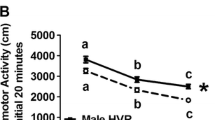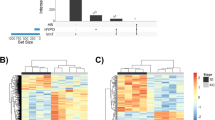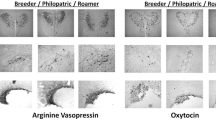Abstract
House mouse lines bidirectionally selected for nest-building behavior show a correlation between number of AVP cells in the suprachiasmatic nuclei (SCN), the master circadian clock in mammals, and level of nest-building behavior as well as a correlation between wheel-running activity and SCN AVP content. Similar genetic correlations between wheel-running activity and nest-building behavior have been reported in house mouse lines selected for increased voluntary wheel-running behavior. These similarities in genetic correlation structure in independently selected mouse lines allowed us to test whether AVP in the SCN and wheel running activity are truly correlated traits under identical testing procedures. In the mouse lines selected for voluntary wheel-running, no difference was found between the lines selected for high levels of voluntary wheel-running and randomly-bred control lines in the number of AVP immunoreactive neurons in the SCN (F 1,6 = 0.09, NS; replicate line effect: F 1,22 = 0.05, NS). This finding was confirmed at the level of individual variation, which revealed no relationship between number of AVP neurons in the SCN and total daily activity (R = −0.086, NS, n = 24), or circadian organization (i.e., the chi-squared periodogram waveform amplitude; R = −0.071, NS). Therefore our data do not support the hypothesis that differences in activity level and the circadian expression of activity in young adult mice are related to differences in the number of AVP-immunoreactive cells in the SCN.
Similar content being viewed by others
References
Amy, S. P., Chari, R., and Bult, A. (2000). Fos in the suprachiasmatic nucleus of house mouse lines that reveal a different phase delay response to the same light pulse. J. Biol. Rhythms 15:95-102.
Bult, A., Hiestand, L., Van der Zee, E. A., and Lynch, C. B. (1993). Circadian rhythms differ between selected mouse lines: A model to study the role of vasopressin neurons in the suprachiasmatic nuclei. Brain Res. Bull. 32:623-627.
Bult, A., Kobylk, M. E., and Van der Zee, E. A. (2001). Differential expression of protein kinase C βI (PKCβI) but not PKCα and PKCβII in the suprachiasmatic nucleus of selected house mouse lines, and the relationship to arginine-vasopressin. Brain Res. 914:123-133.
Bult, A., and Lynch, C. B. (2000). Breaking through artificial selection limits of an adaptive behavior in mice and the consequences for correlated responses. Behav. Genet. 30:193-206.
Bult, A., Van der Zee, E. A., Compaan, J. C., and Lynch, C. B. (1992). Differences in the number of arginine vasopressinimmunoreactive neurons exist in the suprachiasmatic nuclei of house mice selected for differences in nest-building behavior. Brain Res. 578:335-338.
Carter, P. A., Swallow, J. G., Davis, S. J., and Garland, T. Jr., (2000). Nesting behavior of house mice (Mus domesticus) selected for increased wheel-running activity. Behav. Genet. 30:85-94.
Castel, M., Feinstein, N., Cohen, S., and Harari, N. (1990). Vasopressinergic innervation of the mouse suprachiasmatic nucleus: An immuno-electron microscopic analysis. J. Comp. Neurol. 298:172-187.
Garland, T. Jr. (2003). Selection experiments: An underutilized tool in biomechanics and organismal biology. In Gasc, J.-P., Casinos, A., and Bels, V. L. (eds.), Vertebrate Biomechanics and Evolution (pp. 23-56). Oxford, U.K.: BIOS Scientific Publishers.
Groblewski, T. A., Nunez, A. A., and Gold, R. M. (1981). Circadian rhythms in vasopressin deficient rats. Brain Res. Bull. 6: 125-130.
Hofman, M. A., and Swaab, D. F. (1994). Alterations in circadian rhythmicity of the vasopressin-producing neurons of the human suprachiasmatic nucleus (SCN) with aging. Brain Res. 651: 134-142.
Hofman, M. A., and Swaab, D. F. (1995). Influence of aging on the seasonal rhythm of the vasopressin-expressing neurons of the human suprachiasmatic nucleus. Neurobiol. Aging 16: 965-971.
Jin, X., Shearman, L. P., Weaver, D. R., Zylka, M. J., DeVries, G. J., and Reppert, S. M. (1999). A molecular mechanism regulating rhythmic output from the suprachiasmatic circadian clock. Cell 96:57-68.
Koteja, P., Garland, T. Jr., Sax, J. K., Swallow, J. G., and Carter, P. A. (1999). Behaviour of house mice artificially selected for high levels of voluntary wheel running. Anim. Behav. 58: 1307-1318.
Levine, J. D., Funes, P., Dowse, H. B., and Hall, J. C. (2002). Signal analysis of behavioral and molecular cycles. BioMed Central 3:1-25.
Lucassen, P. J., Hofman, M. A., and Swaab, D. F. (1995). Increased light intensity prevents the age related loss of vasopressinexpressing neurons in the rat suprachiasmatic nucleus. Brain Res. 693:261-266.
Meyers, B. L., and Badia, P. (1995). Changes in circadian rhythms and sleep quality with aging: Mechanisms and interventions. Neurosci. Biobehav. Rev. 19:553-571.
Murphy, H. M., Wideman, C. H., and Nadzam, G. R. (1996). Interactions of vasopressin and the photic oscillator in circadian rhythms. Peptides 17:467-475.
Murphy, H. M., Wideman, C. H., and Nadzam, G. R. (1998). The role of vasopressin in modulating circadian rhythm responses to phase shifts. Peptides 19:1191-1208.
Rhodes, J. S. 2002. The neural basis of hyperactive wheel running in mice. Unpublished Ph.D. dissertation. Madison, WI: University of Wisconsin.
Rhodes, J. S., Hosak, G. R., Girard, I., Kelley, A. E., Mitchell, G. S., and Garland, T. Jr. (2001). Differential sensitivity to acute administration of cocaine, GBR 12909, and fluoxetine in mice selectively bred for hyperactive wheel-running behavior. Psychopharmacology 158:120-131.
Shimizu, K., Nagai, K., and Nakagawa, H. (1996). An immunotoxin, anti-VIP antibody-ricin A chain conjugate eliminates neurons in the hypothalamic suprachiasmatic nucleus selectively and abolishes the circadian rhythm of water intake. Brain Res. Bull. 41:369-378.
Silver, R., Sookhoo, A. I., LeSauter, J., Stevens, P., Jansen, H. T., and Lehman, M. N. (1999). Multiple regulatory elements result in regional specificity in circadian rhythms of neuropeptide expression in mouse SCN. Neuroreport 10:3165-3174.
Sokolove, P. G., and Bushell, W. N. (1978). The chi square periodogram: Its utility for analysis of circadian rhythms. J. Theor. Biol. 72:131-160.
Stoinev, A. G., and Ikonomov, O. K. (1990). Effect of continuous vasopressin infusion on circadian rhythms of food and water intake, diuresis, and electrolyte excretion in Brattleboro rats. Bull. Exp. Biol. Med. 109:122-124.
Swallow, J. G., Carter, P. A., and Garland, T., Jr. (1998). Artificial selection for increased wheel running behavior in house mice. Behav. Genet. 28:227-237.
Van den Pol, A. N., and Gorcs, T. (1986). Synaptic relationships between neurons containing vasopressin, gastrin releasing peptide, vasoactive intestinal peptide, and glutamate decarboxylase immunoreactivity in the suprachiasmatic nucleus: Dual ultrastructural immunocytochemistry with gold-substituted silver peroxidase. J. Comp. Neurol. 252:507-521.
Van der Zee, E. A., and Bult, A. (1995). Distribution of AVP and Ca2+-dependent PKC-isozymes in the suprachiasmatic nucleus of the mouse and rabbit. Brain Res. 701:99-107.
Vitaterna, M. H., King, D. P., Chang, A. M., Kornhauser, J. M., Lowrey, P. L., McDonald, J. D., Dove, W. F., Pinto, L. H., Turek, F. W., and Takahashi, J. S. (1994). Mutagenesis and mapping of the mouse gene, Clock, essential for circadian behavior. Science 264:719-725.
Weaver, D. R. (1998). The suprachiasmatic nucleus: A 25-year retrospective. J. Biol. Rhythms 13:100-112.
Author information
Authors and Affiliations
Rights and permissions
About this article
Cite this article
Hochstetler, K.J., Garland, T., Swallow, J.G. et al. Number of Arginine-Vasopressin Neurons in the Suprachiasmatic Nuclei Is Not Related to Level or Circadian Characteristics of Wheel-Running Activity in House Mice. Behav Genet 34, 131–136 (2004). https://doi.org/10.1023/B:BEGE.0000009482.91124.52
Issue Date:
DOI: https://doi.org/10.1023/B:BEGE.0000009482.91124.52




